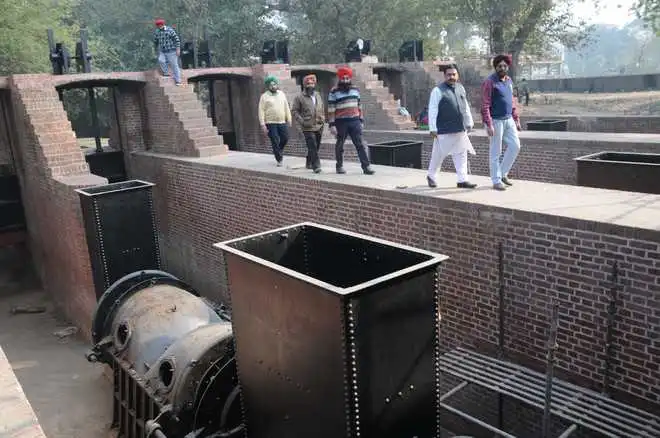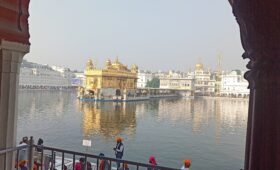Table of Contents
The Rich Historical Background of Amritsar’s First Hydropower Plant 1
Years of Neglect: From Glory to Abandonment 2
The Restoration Journey: A Smart City Project Milestone. 2
Modern Features and Attractions at Tarran Wala Pul 3
Cultural and Economic Significance: Why This Matters for Amritsar 3
Conclusion: A Timeless Bridge Between Past and Future. 3
In the heart of Punjab’s historic city of Amritsar, a remarkable revival has taken place. The once-forgotten British-era hydropower plant at Tarran Wala Pul, originally built in 1930, has been meticulously restored under the ambitious Smart City project. This colonial-era gem, situated along the Upper Bari Doab Canal (UBDC), now stands as a vibrant recreational hub, blending rich heritage with contemporary leisure amenities. After lying defunct for decades, the site reopened in 2025 as a public attraction, drawing visitors eager to explore Amritsar’s industrial past while enjoying scenic views and family-friendly facilities. This transformation not only preserves a piece of British colonial engineering but also positions Amritsar as a key destination for heritage tourism in India, highlighting sustainable urban development initiatives.
As of August 2025, the restored hydropower plant has quickly become a symbol of how historic sites can be repurposed for modern needs. With investments totaling around Rs 5 crore, the project emphasizes eco-friendly restoration techniques, such as using lime instead of cement to maintain the original architecture. For those searching for “Amritsar British-era hydropower plant restoration” or “Tarran Wala Pul tourist spot,” this detailed guide explores its history, revival process, features, and why it deserves a spot on your travel itinerary.
The Rich Historical Background of Amritsar’s First Hydropower Plant
The story of the Tarran Wala Pul hydropower plant begins in the era of British colonial rule in India, a time when innovative engineering projects were transforming the landscape of Punjab. Established in 1930 by the Amritsar Municipal Committee, the plant was a pioneering effort in harnessing renewable energy for urban power supply. Under the supervision of secretary P. Mardson, the facility featured advanced turbines and machinery imported from Switzerland and England, showcasing the global technological exchanges of the period. This made it Amritsar’s first hydropower installation, providing electricity to the city during a time when such infrastructure was rare in the region.
The plant’s origins are deeply tied to the Upper Bari Doab Canal system, a monumental British engineering feat. Construction on the UBDC began in 1849, when the Ravi River was intercepted at Madhopur to create an irrigation network. Completed by 1875, the canal spanned districts including Gurdaspur, Amritsar, and Lahore in undivided Punjab. Today, this 3,119-kilometer-long waterway continues to irrigate vast agricultural lands in Pathankot, Gurdaspur, Batala, and Amritsar, underscoring its enduring importance. The hydropower plant capitalized on the canal’s steady flow, generating power for local needs until larger, more efficient plants emerged in the mid-20th century, leading to its eventual shutdown.
This site reflects broader trends in India’s hydropower history. While the nation’s first hydroelectric plant was commissioned in Darjeeling in 1897 (Sidrapong Hydropower Station), followed by others like Sivasamudram in Karnataka in 1902, Amritsar’s 1930 plant marked a significant step in Punjab’s electrification. It operated successfully for several years, contributing to the city’s growth before being overshadowed by advancements in power generation technology.
Years of Neglect: From Glory to Abandonment
By the late 20th century, the Tarran Wala Pul hydropower plant had fallen into disrepair. Once a bustling industrial site, it became a symbol of neglect, with its machinery rusting and the surrounding area overgrown. Reports from 2019 highlighted how, despite government promises to restore heritage sites in Amritsar, the plant had “lost its glory” amid urban expansion and shifting energy priorities. Decades of inactivity turned it into a forgotten relic, vulnerable to environmental damage and lack of maintenance.
This decline mirrored challenges faced by many colonial-era structures in India, where rapid modernization often sidelined historical assets. Local residents and heritage enthusiasts voiced concerns, urging authorities to intervene. The plant’s location on the UBDC, while scenic, exposed it to natural wear, further exacerbating its deterioration. It wasn’t until the early 2020s that serious revival efforts gained momentum, driven by the national Smart City Mission aimed at revitalizing urban spaces.
The Restoration Journey: A Smart City Project Milestone
The turnaround began in earnest around 2021, when the Amritsar Municipal Corporation announced plans to renovate the British-era hydropower plant under the Smart City project. This initiative, part of India’s broader urban renewal program, focused on converting defunct sites into functional public spaces. By August 2021, officials confirmed the site’s development as a tourist attraction, with local communities advocating for its preservation as a heritage landmark.
Restoration work progressed steadily, with key updates in 2023 indicating that the site had evolved into a picnic spot and was nearing inauguration. The Ministry of Housing and Urban Development, in collaboration with Amritsar Smart City Limited, oversaw the project, ensuring that historical integrity was maintained. Experts used traditional materials like lime for repairs, preserving the original brickwork and architectural style. Century-old trees on the three-acre site were carefully protected, adding to the area’s natural charm.
The total investment of Rs 5 crore covered landscape enhancements, structural reinforcements, and modern amenities. By January 2024, social media buzz, including Instagram reels, celebrated it as a “River Front Park,” highlighting its redevelopment from a 1930s power generator to a leisure destination. Finally, in August 2025, the site reopened to the public, marking 95 years since its inception and fulfilling long-standing calls for its recognition.
Modern Features and Attractions at Tarran Wala Pul
Spanning three acres along the UBDC, the restored hydropower plant now offers a perfect fusion of history and recreation. Key features include:
- Pedestrian Walkways and Landscaped Gardens: Well-paved paths wind through lush greenery, ideal for strolls with views of the canal’s flowing waters.
- Open Gym and Children’s Park: Fitness enthusiasts can use outdoor equipment, while families enjoy play areas designed for kids, promoting healthy lifestyles.
- Canal-View Podiums: Elevated platforms provide panoramic spots for picnics, photography, and relaxation, enhancing the site’s appeal as a riverside retreat.
- Heritage Building Preservation: The original powerhouse structure remains intact, serving as an educational exhibit on colonial engineering and early hydropower in India.
These additions make it a versatile spot for tourists, locals, and history buffs. Unlike traditional museums, it encourages interactive experiences, such as learning about the imported Swiss and English turbines while enjoying the serene environment.
Cultural and Economic Significance: Why This Matters for Amritsar
Despite its value, the site has yet to be officially listed as a tourist attraction by Punjab’s Tourism Department, a point raised by officials and experts who argue it deserves greater promotion. As Amritsar’s industrial heritage landmark, it complements iconic sites like the Golden Temple and Jallianwala Bagh, offering a unique narrative on colonial innovation and sustainable energy.
Economically, the project boosts local tourism, creating jobs in maintenance, guiding, and hospitality. It aligns with India’s push for green urban spaces, potentially inspiring similar restorations elsewhere. Future plans may include guided tours, interpretive centres, or even integration with broader canal heritage trails, further elevating Amritsar’s profile as a multifaceted destination.
Conclusion: A Timeless Bridge Between Past and Future
The revival of Amritsar’s 1930 British-era hydropower plant at Tarran Wala Pul exemplifies how thoughtful restoration can breathe new life into historical sites. From its origins as a power supplier to its current role as a Smart City tourist attraction, this project honours Punjab’s legacy while fostering community engagement. Whether you’re interested in “Amritsar heritage sites,” “Upper Bari Doab Canal history,” or simply seeking a peaceful outing, Tarran Wala Pul promises an enriching experience. As India continues to balance development with preservation, this site stands as a beacon of success—visit soon to witness history reborn.




It’s fascinating to see how the Tarran Wala Pul hydropower plant has been restored to its former glory while adapting to modern needs. The blend of heritage preservation and sustainable development is truly commendable. I wonder how the local community feels about this transformation—has it positively impacted their daily lives or tourism economy? The use of lime instead of cement for restoration is a thoughtful touch; it shows a deep respect for the original architecture. I’d love to know more about the challenges faced during the restoration process—were there any unexpected hurdles? Also, how accessible is the site for visitors with disabilities? This project seems like a perfect example of how history and modernity can coexist harmoniously.
By the way, we’ve integrated libersave into our regional voucher system. It’s amazing how easily it consolidates various providers on one platform. Whith regards, FEWFE